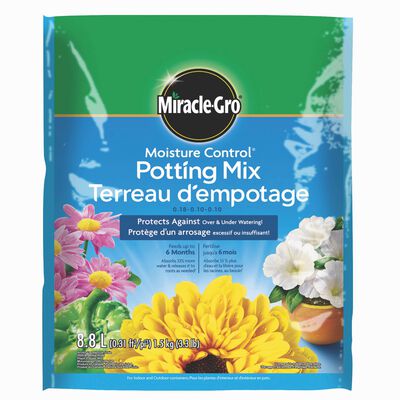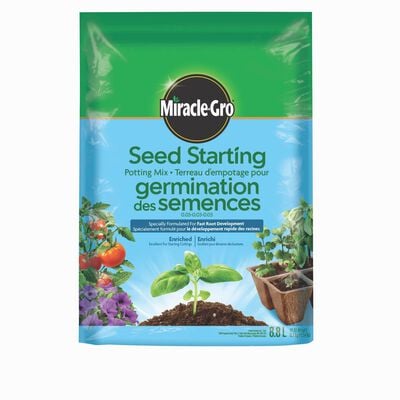
Growing Peppers
- Plant peppers in spring once nightly temperatures stay at or above 13 °C (55 °F).
- Grow peppers in a spot that gets 6-8 hours of sun daily.
- Harvest sooner by starting with young pepper plants.
- Improve soil nutrition and drainage by adding Miracle-Gro® Garden Soil All Purpose (in-ground), Miracle-Gro® Moisture Control® Potting Mix (containers).
- Check soil often and water whenever the top inch of soil is dry.
- Add a 3-inch layer of mulch to help retain moisture in the soil.
- One month after planting, begin feeding regularly with Miracle-Gro® Shake 'N Feed® Tomato, Fruits & Vegetables Plant Food.
- Harvest peppers when they reach their ideal colour.
Whether your taste buds tend toward sweet, pungent, or sizzling, peppers deliver. In the kitchen, they easily fill the roles of appetizer (think jalapeno poppers), salad garnish, or main course (chile rellenos). Thin-walled peppers cook quickly, making them a natural for pickling or frying. Thicker-walled bell peppers make terrific stuffed peppers or grilled kebabs. When it comes to peppers, there's something for every cooking style and palate.
Here's how to grow peppers in your home garden.
Prep
Growing peppers isn't difficult. They crave sun and heat. Plan to plant your pepper patch in a spot that receives six to eight hours of sun daily. Soil should provide a nutrient-rich base that drains well. To create that ideal growing environment, fill containers with Miracle-Gro® Moisture Control® Potting Mix. For in-ground planting beds, mix 3 inches of Miracle-Gro® Garden Soil All Purpose into the top 6 to 8 inches of soil. In raised beds, blend equal parts of garden soil and potting mix.
Plant
Peppers are a warm-season crop that should go into the garden when soil and air have warmed, with nights steadily above 13 °C (55 °F). Don't set plants out too early in spring. Wait until one to two weeks past your region's average last frost date.
Start with strong, vigorous young plants to give you a significant head-start down the road to harvest time. Or, if you prefer, you can grow peppers from seed. This requires sowing seeds indoors about eight to 10 weeks before your region's average last frost date. Sow three pepper seeds per pot, in Miracle-Gro® Seed Starting Potting Mix. Peppers have a notorious reputation for slow germination, taking anywhere from 14 to 21 days. Hot peppers usually take the longest, needing up to 3 weeks to germinate. After the first set of true leaves appear, thin seedlings to the strongest one. If necessary, transplant seedlings into larger containers until they're ready to go into the garden. Whether you start with young plants or your own seedlings, in the garden, space plants 18 to 24 inches apart (depending on variety), or one plant per 18-inch (or larger) pot. Water thoroughly after planting.
As peppers form, branches can break under the weight, especially during summer storms. Support each plant with a stake or small tomato cage at planting time.
Grow
Pepper plants need consistent soil moisture to yield well. Check the soil: When the top inch is dry, you need to water. If a busy schedule or forgetfulness makes watering unlikely, install a soaker hose or drip irrigation.
Mulch around plants with 2 to 3 inches of Scotts® Nature Scapes® Colour Enhanced Mulch. Mulch helps reduce weeds and keeps soil moist, which can reduce watering chores.
Growing peppers need a steady supply of plant food, which works in tandem with great soil to help your plants produce an amazing harvest. Miracle-Gro® Shake 'N Feed® Tomato, Fruits & Vegetables Plant Food will feed your pepper plants for up to 6 weeks, providing loads of extra nutrients to the beneficial microbes in the soil as well as to the plants. A month after planting, mix this into the soil around your pepper plants, following label directions.
Harvest
As peppers ripen, color shifts from green to red (even green peppers eventually turn red) or whatever hue the pot tag or seed packet indicates. You can pick peppers at any point in their color journey, but flavors change as colors intensify. The longer hot peppers remain on a plant, the stronger the heat becomes.
Harvest with a knife or shears, cutting peppers from the plant. Leave a short stem stub attached to the pepper to help it last longer. Store almost ripe peppers in a warm spot, like on the kitchen counter or near a bright window. If you see any softening or shriveling skin, move them to the fridge. Refrigerate fully ripe peppers in a vegetable storage drawer set to high humidity.
Use care when handling hot peppers. Capsaicin, the compound that produces heat in peppers, is concentrated primarily in the veins, ribs, and seeds. To be on the safe side, wear gloves when working with hot peppers.
Use
In the kitchen, use fresh peppers in sandwiches, salads or salsa, or roast or fry them to include in other dishes. Peppers taste fantastic tossed on the grill, and they make wonderful pickles or jam. Freezing peppers works well, especially for ones you plan to use later in cooking. Ready to start planting and growing your own peppers? Click on any of the product links above for more information.



